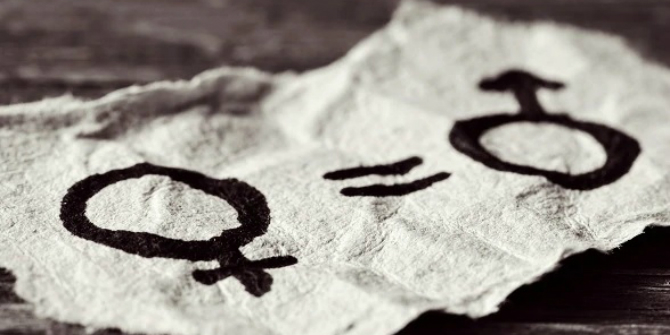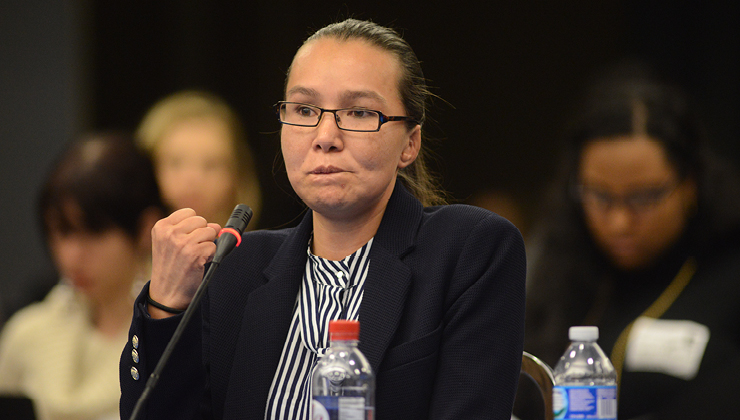As we, in the UK, celebrate the 100th anniversary of women (or rather some women) being given the vote, Louise Arimatsu and Lisa Gormley reflect on the fight for women’s suffrage within the broader international context to ask what lessons we can learn a century on.
The struggle for women’s suffrage in the UK took place against the backdrop of three other progressive ‘transnational’ campaigns of the day: the anti-slavery movement, the movement for improved labour protection and the women’s peace movement. The common theme linking all these campaigns was the call for equality – political, social and economic. That said, each of these movements encompassed different strands and philosophies with activists often dividing on the question of whether the means pursued justified the stated ends. The outbreak of war in Europe exposed and sharpened divisions, including among those activists calling for women’s suffrage. While many women, including those who had advocated civil disobedience in pursuit of votes for women, opted to redirect their activities towards contributing to the war effort those who favoured pacifism often paid a high personal price.

The war was to have a profound effect on the lives of women generally. As the fighting spread and intensified, increasing numbers of women began to offer their services to the Local Relief Committees, the War Office and the Red Cross; thousands joined the nursing services including the Army Nursing Service, Voluntary Aid Detachments, the Territorial Forces Nursing Service and the Queen Alexandra’s Military and Naval Nursing Service. In the early months of the war, women’s groups played a pivotal role in helping to absorb the huge influx of Belgian refugees – estimated to be in the region of 250,000 people – fleeing the violence on the continent. By 1915, women were also entering workplaces traditionally dominated by men. Although initially resisted by the unions, opposition soon dissipated under the growing need for labour to support the war effort.
Much has been written about how war disrupts traditional gender roles which, in turn, open up the space for post-war political reform. The argument that the changing role of women during WWI was a contributing factor to women gaining vote is a compelling one. But the paradox of war is it concurrently reinforces traditional gender roles including, the identification of masculinity with militarism: in many respects, the legacy of WWI was no exception. Moreover, rather than being moments of transformation, post-conflict peacebuilding efforts have often emphasised the restoration of societies to their pre-conflict condition enabling – intentionally or otherwise – the reinstatement of patriarchal systems, including at the international level.
The exclusion of women’s groups from both the Paris Peace talks (1919-1920) and the efforts to establish a new global order through the League of Nations was a huge disappointment for women’s groups. The progressive ideas advocated by women activists in 1915 at the International Congress of Women – including demands for new international norms on citizenship and the enfranchisement of women as an integral aspect of securing peace – were ignored by states and dismissed as domestic issues and not of universal concern. As a consequence, most European governments chose not to extend the vote to women (in France the Senate repeatedly rejected motions to enfranchise women) perpetuating this overt form of discrimination. Although the UK was one of the first European states to enfranchise women, the 1918 Representation of People Act only did so for a privileged class of women (those over 30 with a property qualification). It would be another ten years before the right was extended to all women on an equal basis with men. Elsewhere in Europe progress was even slower: women in Spain would wait until 1931; in France, until 1944; in Italy, until 1946. Switzerland did not enfranchise women until 1971.
It was not until after World War II, and three decades after the International Congress when states finally recognised that women’s enfranchisement was a matter of international concern, a human right. Today, the right is firmly established in international legal instruments including the 1948 Universal Declaration of Human Rights (Article 21), the 1952 Convention on the Political Rights of Women, the ICCPR (Article 25) and the 1979 Convention on the Elimination of Discrimination against Women (Article 7). For women activists the right to vote always represented more than simply the right to participate in elections. For example, speaking at the United Nations on the adoption of the 1952 Convention Eleanor Roosevelt observed “the first objective of this convention is to encourage equal political rights for women in all countries. But its significance reaches far deeper into the real issue of whether in fact women are recognized fully in setting the policies of our governments.” The CEDAW Committee has likewise interpreted Article 7 broadly reminding state that women “must be fully and equally involved in decision-making at all levels, both nationally and internationally, so that they may make their contribution to the goals of equality, development and the achievement of peace”.
Today, there is widespread recognition among states that the participation of women is a critical pre-requisite to the success of conflict resolution and peacebuilding: after all, ‘participation’ constitutes one of the four pillars of the UN Security Council’s Women, Peace and Security agenda and appears in all eight resolutions. On some fronts, the WPS agenda has delivered: the involvement of women, women’s groups and gender experts has risen over the last 18 years as has the frequency of “gender responsive language in peace agreements”. At the same time, as frequently observed, women’s involvement has often been temporary, symbolic and limited notwithstanding the mounting evidence to show that the likelihood of securing a sustainable peace is greater with increased participation.
The progress achieved over the last century has been significant, in large measure due the bravery of the many women who endured hard labour in prison, hunger-strikes, force-feeding at the hands of the state, aggravated by opposition from within families and censure and exclusion by their own communities. The women who campaigned tirelessly for equality at the ballot box and for an alternative vision of the international order founded on justice and the rule of law leave us much to reflect on. But if these two women’s movements teach us anything, it is that when we unite to work together for a common cause anything is possible.
At the global level, securing women’s suffrage has admittedly taken decades to achieve. And although we are nearly there, the right to vote is no guarantee to being heard. The caution expressed by the CEDAW Committee two decades ago that, in times of crisis, women’s voices have been silenced and their contribution and experiences to society are ‘rendered invisible’ still resonates today. Thus, as they did so a century ago, women will continue to meet resistance in being heard in conflict and post-conflict environments. The barriers are formidable; but, in contrast to a century ago, we are better equipped. The international legal tools we have at our disposable assist us in the fight against the reinstatement of patriarchal systems and have the potential to usher in transformative change founded on a rights based approach. We just need to remain steadfast in our belief that we can effect change as those women did a century ago.
LSE Library has created a programme of events drawing on the rich material in The Women’s Library Collection to commemorate the campaigns for women’s suffrage and the innovative methods used to get the vote. Find out more: Suffrage 18: a centenary exploration at LSE
The views, thoughts and opinions expressed in this blog post are those of the author(s) only, and do not reflect LSE’s or those of the LSE Centre for Women, Peace and Security.





